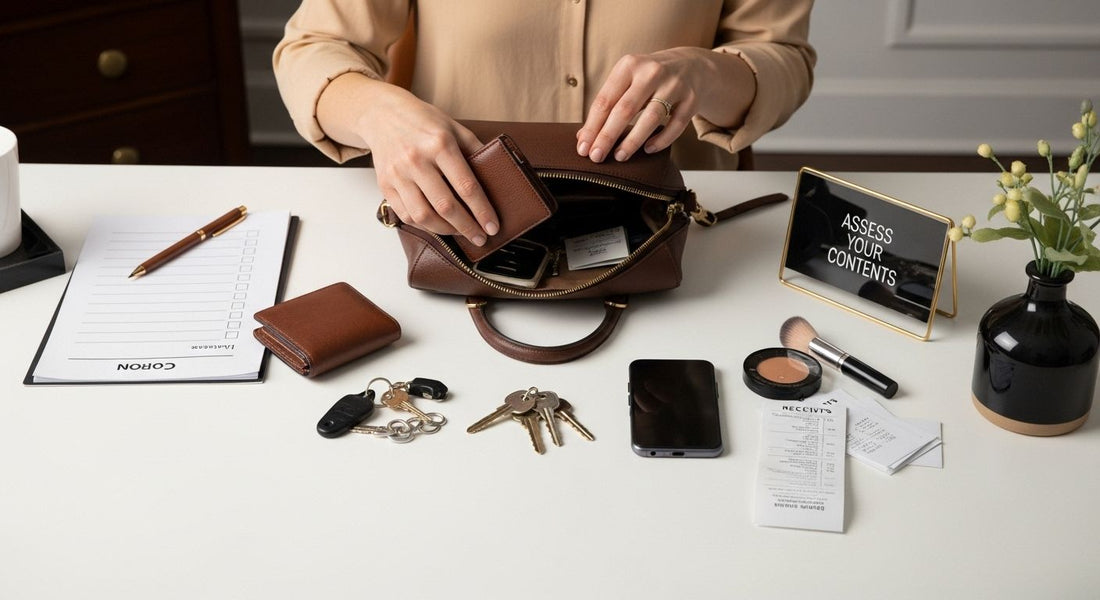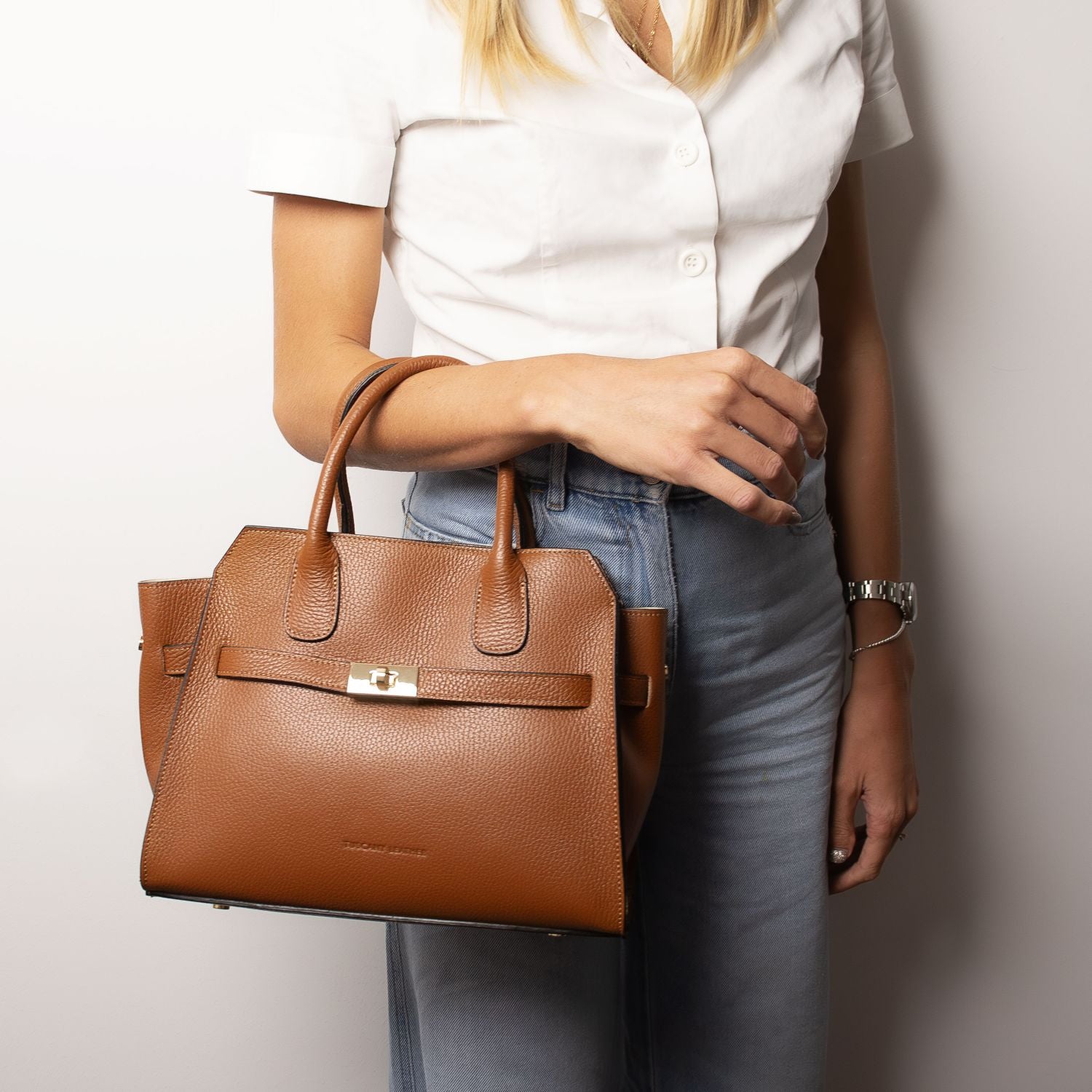
Organizing Your Handbag: Elevate Style and Functionality
Share

Most of us carry far more in our handbags than we ever realise. A fully packed handbag can easily exceed five kilograms, which is enough weight to strain your shoulders and neck every single day. People assume clearing out clutter is the obvious fix. This misses a much bigger opportunity. The real secret is not just about what you remove, but how you rethink every item and its purpose—transforming your bag into a tool that genuinely makes life easier.
Table of Contents
- Step 1: Assess Your Current Handbag Contents
- Step 2: Categorise Your Essentials By Function
- Step 3: Choose Organisational Accessories Wisely
- Step 4: Arrange Items For Optimal Accessibility
- Step 5: Regularly Evaluate And Refresh Your Handbag
Quick Summary
| Key Point | Explanation |
|---|---|
| 1. Assess Your Handbag Contents | Empty your handbag to evaluate and categorise items, removing clutter and unnecessary items for better organisation. |
| 2. Categorise by Function | Group items based on their primary use, enhancing accessibility and making it easier to find essentials. |
| 3. Choose Organisational Accessories Wisely | Select multi-functional organisational tools that enhance structure and accessibility without adding bulk. |
| 4. Arrange for Accessibility | Position frequently used items in easy-to-reach locations and create logical zones to simplify retrieval. |
| 5. Regularly Refresh Your Handbag | Set a schedule for regular evaluations to maintain organisation and adapt your handbag to changing needs. |
Step 1: Assess Your Current Handbag Contents
Organizing your handbag begins with a comprehensive assessment of its current contents. This initial step is crucial for understanding what you carry and why, setting the foundation for a more streamlined and functional accessory. Emptying your handbag completely allows you to evaluate every single item and make deliberate decisions about what truly belongs.
Start by finding a clean, spacious surface like a table or desk where you can spread out all of your handbag’s contents. Remove every single item carefully, placing them into logical groupings. Group similar items together - such as personal documents, makeup, electronic devices, and miscellaneous accessories. This visual sorting helps you quickly identify unnecessary items and potential organizational opportunities.
As you sort through your belongings, according to the Mayo Clinic, pay close attention to the weight and distribution of items. Carrying an excessively heavy bag can lead to unnecessary strain on your shoulders and neck. Your goal is to create a lightweight, purposeful collection of essentials that supports your daily activities without causing physical discomfort.
Carefully examine each item and ask yourself critical questions: When was the last time I used this? Does this item serve a genuine purpose in my daily routine? Could this be stored elsewhere? Many individuals accumulate unnecessary items in their handbags out of habit or perceived necessity. Be ruthless in your assessment, removing expired receipts, old tickets, worn-out lip balms, and other clutter that serves no current function.
Consider creating a simple categorization system during this assessment:- Essential Items: Keys, wallet, phone, primary identification- Occasional Necessities: Compact makeup, hand sanitiser, portable charger- Removable Items: Multiple loyalty cards, outdated paperwork, unnecessary cosmetics
By meticulously reviewing your handbag’s contents, you transform a potentially chaotic space into an intentionally organized system that reflects your lifestyle and professional needs. This foundational step sets the stage for a more efficient and elegant approach to managing your personal accessories.
Step 2: Categorise Your Essentials by Function
Transforming your handbag from a cluttered catchall into a purposefully organized accessory requires strategic categorisation. Functional organisation is not about reducing what you carry, but about creating a logical system that makes every item easily accessible and purposeful. This step focuses on grouping your essentials according to their primary use and frequency of interaction.
Begin by creating distinct functional categories that align with your daily lifestyle. Professional accessories might include work-related items like business cards, portable chargers, and compact notebooks. Personal care essentials could encompass makeup, hand sanitiser, compact mirror, and emergency grooming tools. Health and wellness items might include medication, small first aid supplies, and personal wellness products.
According to Harvard Health, establishing a consistent storage system for daily items can significantly reduce time spent searching and increase overall efficiency. Consider investing in small, lightweight organisational tools that help maintain these categories within your handbag. Slim zippered pouches, compact compartment organisers, and clear small bags can help you create distinct zones for different item types.
Carefully consider the weight and accessibility of each category. Place frequently used items like your mobile phone and wallet in easily reachable external or top compartments. Less frequently used items such as emergency supplies or backup chargers can be stored in deeper interior sections. The goal is to create a fluid, intuitive system where you can retrieve what you need without disrupting the entire bag’s organisation.
Your functional categories might include:
- Professional Toolkit: Work documents, business cards, portable tech accessories
- Personal Care Essentials: Makeup, hygiene items, compact mirror
- Emergency Preparedness: Mini first aid kit, spare cash, compact umbrella
Remember that effective categorisation is a personal process. What works perfectly for one individual might feel cumbersome for another. Be patient with yourself and remain flexible, adjusting your system as you discover what truly supports your daily rhythm and professional needs. By thoughtfully organising your handbag’s contents, you transform a simple accessory into a carefully curated collection of purposeful items.

Step 3: Choose Organisational Accessories Wisely
Selecting the right organisational accessories transforms your handbag from a simple container into a sophisticated, functional system. The key is not about acquiring more items, but choosing precise, multi-functional tools that enhance your bag’s internal structure and accessibility. These accessories should integrate seamlessly with your lifestyle, creating an intuitive environment for your essentials.
Consider investing in high-quality, slim organisational tools that maximise space without adding unnecessary bulk. Leather or durable fabric pouches with multiple compartments can help segment your items while maintaining an elegant aesthetic. Look for accessories with clear sections, zippered pockets, and versatile designs that can adapt to different bag sizes and styles. Compact organisers with designated spaces for cards, technology, and personal care items can dramatically improve your bag’s internal management.
According to research exploring handbag design, thoughtful accessories are critical in creating a functional personal storage system. Prioritise accessories that offer structure without compromising the bag’s overall shape or weight. Lightweight materials like microfibre or thin leather provide durability without adding significant weight to your handbag.
Your organisational accessories should serve multiple functions. A smartphone charging pouch that also protects your device, a card holder with RFID blocking technology, or a compact mirror with built-in storage demonstrates intelligent design. Seek out accessories that solve multiple challenges simultaneously, reducing the number of individual items you need to carry.
Consider these strategic accessory selections:
- Tech Protection: Padded, slim cases for electronics
- Document Management: Slim wallets with multiple card slots
- Personal Care: Compact, leak-proof pouches for cosmetics
Remember that organisational accessories are personal investments. What works perfectly for a corporate professional might differ from the needs of a creative freelancer or a busy parent. Take time to experiment, be willing to adjust your approach, and select accessories that genuinely complement your daily routine and personal style. The goal is creating a handbag ecosystem that feels effortless and intuitive, supporting your lifestyle with subtle, intelligent design.
Below is a table summarising suggested handbag organisational accessories, detailing their primary use and the benefits they offer for efficient storage and structure.
| Accessory Type | Primary Purpose | Key Benefit |
|---|---|---|
| Slim Pouch | Segment personal care or tech | Maintains separation without bulk |
| Card Holder (RFID) | Secure cards and IDs | Protects data, easy card retrieval |
| Organiser Insert | Divide handbag into compartments | Provides structure and zones for items |
| Padded Tech Case | Protect electronics | Prevents damage, keeps tech accessible |
| Leak-proof Bag | Contain cosmetics or liquids | Prevents spills inside handbag |
| Multi-compartment Wallet | Organise cash/cards/documents | Consolidates finances and paperwork |
| Compact Mirror Storage | Dual purpose: mirror + storage | Saves space, easy grooming on the go |
Step 4: Arrange Items for Optimal Accessibility
Optimal accessibility transforms your handbag from a simple storage space into an intelligent, responsive system that anticipates your needs. The strategic placement of items is not just about organisation, but about creating an intuitive internal landscape that allows you to retrieve what you need with minimal disruption. This step focuses on developing a thoughtful arrangement that prioritises efficiency and ease of use.
Begin by considering your most frequently accessed items and position them in the most convenient locations. Your mobile phone, keys, and wallet should occupy the most readily available sections of your handbag - typically external pockets or top compartments that require minimal reaching or searching. This principle of proximity ensures that essential items are always within immediate reach, reducing the frustration of rummaging through multiple layers.
According to research on ergonomic design, the arrangement of items significantly impacts the functional efficiency of personal accessories. Consider creating a weight distribution strategy that places heavier items closer to the bag’s centre and bottom. This approach prevents unnecessary strain on your shoulders and maintains the bag’s structural integrity. Lighter items like tissues, lip balm, or portable chargers can be positioned in upper or side compartments for quick access.
Think about creating distinct zones within your handbag that correspond to different aspects of your life. A professional section might include business cards, a compact notebook, and a sleek pen. A personal care zone could house makeup, hand sanitiser, and a compact mirror. By establishing these intentional territories, you create a mental map that makes navigation automatic and stress-free.

Consider these strategic placement principles:
- Proximity Priority: Most used items in easiest-to-reach zones
- Weight Distribution: Heavier items at the bottom centre
- Logical Grouping: Related items stored together
Remember that your handbag’s internal landscape is dynamic. Periodically reassess your arrangement, noting how your daily routine and needs evolve. What works perfectly during a professional week might require adjustment for weekend activities. The goal is to create a flexible, responsive system that adapts to your changing lifestyle while maintaining a core principle of intuitive accessibility. Your handbag should feel like an extension of your organisational approach - seamless, intelligent, and uniquely tailored to your personal rhythm.
Step 5: Regularly Evaluate and Refresh Your Handbag
Maintaining an organised handbag is not a one-time event, but an ongoing process of mindful curation and periodic assessment. Regular evaluation transforms your handbag from a static storage space into a dynamic, responsive system that evolves with your lifestyle. This final step ensures that your carefully constructed organisational strategy remains relevant, functional, and aligned with your changing personal and professional needs.
Establish a consistent rhythm for handbag maintenance, ideally conducting a thorough review every two to four weeks. Choose a specific day and time that fits naturally into your routine - perhaps a quiet Sunday evening or a calm weekend morning. During this dedicated refresh session, completely empty your handbag, examining each item with a critical and objective perspective. Look for signs of wear, expired items, accumulated unnecessary receipts, or objects that no longer serve a genuine purpose in your daily life.
According to research on personal organisation, regular decluttering can significantly reduce stress and improve mental clarity. Your handbag refresh is more than a physical reorganisation - it’s an opportunity for personal recalibration. Remove items that have accumulated accidentally, replace worn organisational accessories, and reassess your current functional categories. Consider how your professional or personal circumstances might have shifted, requiring adjustments to your handbag’s internal ecosystem.
Develop a systematic approach to your refresh process. Clean the interior of your handbag, wiping down surfaces and checking for any minor repairs or maintenance needs. Inspect your organisational accessories for functionality, replacing them if they show signs of wear or no longer support your current organisational strategy. This is also an ideal time to rotate seasonal items, ensuring your handbag remains adaptable to changing environments and professional requirements.
Consider these refresh evaluation points:
- Item Relevance: Remove anything unused in the past month
- Accessory Condition: Check organisational tools for wear
- Seasonal Adaptation: Update contents for current environment
Remember that your handbag is a personal tool that should adapt and grow with you. Some weeks might require more intensive reorganisation, while others might need only minor adjustments. The goal is to maintain a flexible, intuitive system that supports your lifestyle without becoming a source of stress. By approaching your handbag as a dynamic, evolving accessory, you transform it from a mere storage solution into a sophisticated, personalised organisational companion.
This table serves as a practical checklist to help guide you through your regular handbag refresh, reminding you of the most important aspects to review for sustained organisation.
| Refresh Evaluation Point | Description | Example Action |
|---|---|---|
| Item Relevance | Remove anything not used in the past month | Discard old receipts or tickets |
| Accessory Condition | Check for wear and tear on organisational tools | Replace torn pouch or wallet |
| Seasonal Adaptation | Update contents to match current needs and climate | Add umbrella or sunglasses |
| Cleanliness | Wipe down and check bag interior for debris | Clean out crumbs and dust |
| Functional Categories | Reassess if item groupings still suit your routine | Move charger to tech pouch |
Experience Functional Elegance with San Rocco Italia
If you are ready to turn handbag chaos into calm, your journey deserves a partner that values both beauty and purpose. All throughout “Organising Your Handbag: Elevate Style and Functionality,” you have seen how structure, quality, and intentional detail make all the difference. Yet the real transformation begins when you choose accessories that truly reflect your taste while supporting your daily needs. That is where expertly crafted solutions from San Rocco Italia come into play.

Take the next step and replace clutter with clarity. Our collection of luxury handbags and accessories—crafted from premium full-grain Italian leather—gives you the perfect canvas for building a smart and stylish system, just as outlined in the article. Discover timeless pieces made by skilled artisans that provide the functionality, elegance, and lasting quality your daily routine demands. Explore the full range at San Rocco Italia and bring organisation and sophistication together—your effortless handbag starts now.
Frequently Asked Questions
How can I effectively assess the contents of my handbag?
Start by completely emptying your handbag onto a clean surface and grouping items by category, such as essentials, occasional necessities, and removable items. Assess each item’s relevance and purpose in your daily routine to identify clutter.
What are some effective ways to categorise my handbag’s contents?
Create distinct categories based on function, such as professional tools, personal care items, and emergency supplies. This organisation helps to streamline access to your essentials, making it easier to find what you need.
How can I choose the right organisational accessories for my handbag?
Select slim, high-quality organisational tools that offer multiple compartments while adding minimal bulk to your handbag. Look for pouches with clear sections or zippered pockets that help maintain an elegant aesthetic and assist in categorisation.
What tips can help me arrange items for optimal accessibility in my handbag?
Place frequently used items, like your wallet and phone, in the most accessible compartments, such as external pockets. Heavier items should be stored closer to the bottom for better weight distribution, while lighter items can go in upper compartments for quick reach.


